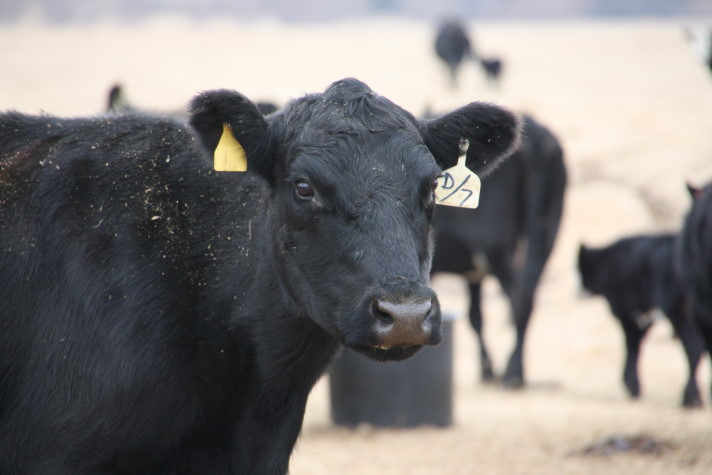
Agricultural News
Beef Cow Herd Growth Will be Modest- At Best- in 2011
Tue, 01 Feb 2011 8:39:56 CST
 According to Oklahoma State University Extension Livestock Market Economist Dr. Derrell Peel, the much anticipated USDA Cattle report confirmed that the beef industry is beginning 2011 with a small cow herd, limited replacement heifers and even tighter feeder supplies. The beef cow herd decreased 1.6 percent in 2010 to a January 1, 2011 total of 30.9 million head. The inventory of beef replacement heifers dropped 293 thousand head to 5.16 million head available as of the beginning of 2011. Despite smaller replacement heifer inventories, estimated feeder supplies decreased by 3.3 percent compared to a year ago, as a result of aggressive feedlot placements late in 2010. The question of how much herds expand in 2011will affect beef production in both the short run and the long run.
According to Oklahoma State University Extension Livestock Market Economist Dr. Derrell Peel, the much anticipated USDA Cattle report confirmed that the beef industry is beginning 2011 with a small cow herd, limited replacement heifers and even tighter feeder supplies. The beef cow herd decreased 1.6 percent in 2010 to a January 1, 2011 total of 30.9 million head. The inventory of beef replacement heifers dropped 293 thousand head to 5.16 million head available as of the beginning of 2011. Despite smaller replacement heifer inventories, estimated feeder supplies decreased by 3.3 percent compared to a year ago, as a result of aggressive feedlot placements late in 2010. The question of how much herds expand in 2011will affect beef production in both the short run and the long run.
Possible beef cow herd expansion in 2011depends on several factors including how aggressively producers are trying to expand and what Mother Nature will allow the industry to do. Both of these are uncertain as producer intentions are not clear and the potential for significant drought continues to grow this winter. More fundamentally, the inventory numbers themselves suggest limits on what is possible and the implications of various expansion scenarios. Herd expansion will depend on the net change in cow numbers that result from cow culling and heifer placement in the herd. Cow culling has been at very high levels the last three years and the percent of the beef cow herd culled in 2010 was the highest level of any time in the last twenty years.
Although the number of heifers available as replacements is known from the inventory report, changes in the herd inventory over the year will depend on the percentage of heifers that actually enter the herd. In the last twenty years, an average of about 53 percent of reported replacement heifers on January 1 actually enter the herd during the year. The remaining heifers end up in the feeder supply for one reason or another. Over the last twenty years, this value has varied from a low of 45 percent to a high of about 60 percent, with one spike up to 69 percent in 1993. Not surprisingly, this percentage tends to increase during herd expansion and decrease during liquidation. In fact, this percentage often increases before the replacement heifer inventory begins to increase and is thus something of a leading indicator of herd expansion. Interestingly, this value increased sharply in 2009 and 2010, and although no herd expansion occurred, the implication is that herd decreases would have been more pronounced without this increased intensity of heifer placement. The actual number of heifers entering the beef herd increased each of the last three years because a higher percentage of a smaller replacement inventory was being utilized. In fact, the 2010 value of 57 percent was the fourth highest percentage of replacement heifers entering the herd in the period since 1990. The three higher percentages occurred in 1990, 1991 and 1993, all herd expansion years.
What is the impact on beef cow herd size if the trends of 2010 continue in 2011? Given the inventory values for January 1, beef cow culling (slaughter) and heifer placement at last year's rates would result in approximately another 1.9 percent decrease in the beef cow herd by January 1, 2012. A cow culling rate at the slightly lower 2008-2010 average would result in roughly a 1.5 percent decrease in the herd at current heifer placement rates. If the heifer placement rate drops to an average level, the herd size would decrease by 2 to 2.5 percent this year.
Is it possible to increase the beef cow herd in 2011? It will take roughly a 15 percent drop in beef cow slaughter year over year, at current heifer placement rates to hold the beef cow herd at current levels. A 15 percent drop in cow slaughter combined with even higher heifer placement rates could support up to a 0.5 percent increase in the beef cow herd. The required cow culling and heifer placement rates are possible but both would be near the limits of what has been observed in the past twenty years. However, even though 15 percent decreases in cow slaughter in one year have been observed in previous cattle cycles, strong cull cow values makes this less likely now. These reductions in cow slaughter and increased heifer placements have significant implications for slaughter supplies in 2011. Given, these limits, it appears that cow herd growth in 2011 is likely to be modest, at best, even if producers are ready and Mother Nature cooperates.
Today's analysis of the beef cow numbers in this country has been offered by Dr. Derrell Peel of Oklahoma State University.
WebReadyTM Powered by WireReady® NSI
Top Agricultural News
More Headlines...




















